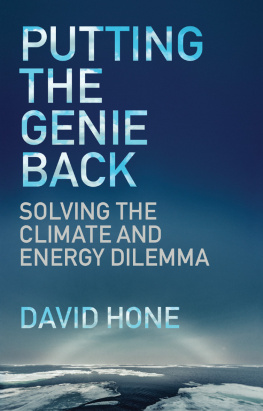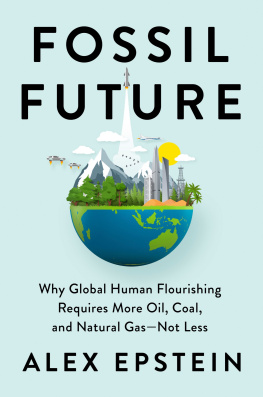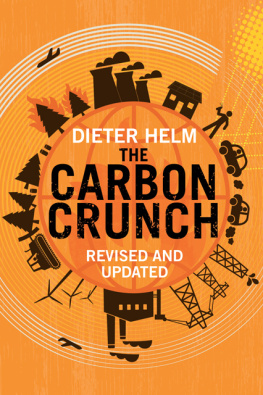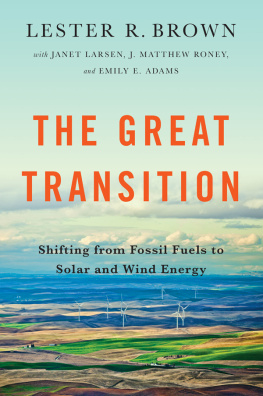BURN OUT

Copyright 2017 Dieter Helm
All rights reserved. This book may not be reproduced in whole or in part, in any form (beyond that copying permitted by Sections 107 and 108 of the U.S. Copyright Law and except by reviewers for the public press) without written permission from the publishers.
For information about this and other Yale University Press publications, please contact:
U.S. Office:
Europe Office:
Typeset in Minion Pro by IDSUK (DataConnection) Ltd
Printed in Great Britain by TJ International Ltd, Padstow, Cornwall
Library of Congress Cataloging-in-Publication Data
Names: Helm, Dieter, author.
Title: Burn out : the endgame for fossil fuels / Dieter Helm.
Description: New Haven : Yale University Press, [2017] | Includes
bibliographical references and index.
Identifiers: LCCN 2016043323 | ISBN 9780300225624 (c1 : alk. paper)
Subjects: LCSH: Energy industries. | Energy developmentEnvironmental
aspects. | Energy consumptionEnvironmental aspects. | Renewable energy
sources. | Fossil fuelsEnvironmental aspects.
Classification: LCC HD9502.A2 H4549 2017 | DDC 333.8/2dc23
LC record available at https://lccn.loc.gov/2016043323
A catalogue record for this book is available from the British Library.
10 9 8 7 6 5 4 3 2 1
To Sue, Oliver and Laura as always
Contents
Preface and Acknowledgements
When you read this, the oil price could be anywhere between $20 and $100 a barrel. It could even be outside these boundaries. Although it will matter a lot to the companies, traders and customers, it will not tell you very much about the price in the medium-to-longer term. The fact that the price was $147 in 2008 and $27 in early 2016 just tells you that it is volatile. Bankers, investors and governments might get their fingers badly burned, but most will lick their wounds and survive another day if the falls since late 2014 are only temporary. But only if they are temporary.
From the perspective of our energy future, it is the trend and not the noise that matters. Until late 2014, there was a broad consensus about where prices were heading up, ever up. Otherwise sensible and sane people convinced themselves that the world was running out of oil, and that demand was virtually insatiable from ever-growing China and the other developing countries in Southeast Asia, India and Africa. Constrained and then falling supply would collide with ever-rising demand, and there would be an economic shock making those caused by OPEC in the 1970s look tame.
Lest you think this is exaggerated, it is all there in the actions of the companies, the trail of quotes, statements and reports, and embedded in energy policies around the world, and especially in Europe. The oil companies were busily developing new resources at costs of up to or even above $100 a barrel. These ranged from the Arctic through to the tar sands in Canada. They put their money where their analysis had taken them.
Experts and institutions produced reports and books about peak oil and the urgent need to diversify to protect customers and economies from the price shocks to come. Websites about peak oil abounded. To argue against peak oil in the mid-to-late 2000s was very much a minority sport and open to ridicule. It ran on well into the current decade, right up to the oil price collapse in late 2014.
The environmentalists and politicians bought into this narrative. They talked a lot about the coming shocks, and this played wonderfully into the hands of those lobbying for subsidies for nuclear and renewables. They could tell a story about how nuclear and renewables, though expensive now, would be in the money by around 2020, by which time oil and especially gas prices would have moved above the (high) costs of these low-carbon options. Ministers even got into the business of forecasting lower relative prices from the renewables. Nuclear in Britain was presented as a long-term bargain. Germany convinced itself that the Energiewende would be a good industrial strategy, capable of giving Germany a competitive (renewables) edge against the fossil-fuel-dependent US.
Companies dispensed large amounts on high-cost marginal investments; investors bought their shares; banks lent them lots of money; and energy customers were committed to paying for large-scale renewables programmes in offshore and onshore wind and first-generation solar. All any lobbyist needed was to come armed with a forecast of ever-higher fossil fuel prices.
It has all turned out very differently, at least in the short term. It may swing back again. Indeed it may already have done so by the time you read this. Or it may not. But this book is not about these short-term swings. It is about why fossil fuel prices may, in the medium and longer term, be heading gradually down; why, notwithstanding the price today or indeed on any given day, it is reasonable to expect the prices further out to fall. This is a book about the gradual demise of the fossil fuel industries, and how the transition will play out.
The end of fossil fuels is a comforting idea for many environmentalists, and in the end it probably will solve climate change. But it is unlikely to play out in a neat way, or as a consequence of campaigns and political actions. We may end up leaving the superabundant fossil fuels in the ground, but it is unlikely to come about through boycotts, demonstrations and campaigns about stranded assets.
The element of realism injected back into the markets from 2014 has been painful for companies, investors, renewables developers struggling to cope with cheaper gas, and for electric vehicles trying to compete with their oil-fuelled counterparts. But this is just a beginning. For the great oil-producing countries, such as Russia and Saudi Arabia, it is no picnic. It threatens the very survival of their autocratic regimes and the livelihoods of their citizens. By contrast, the new energy world is a much better place for the US and Europe.
These impacts are the result of the ways in which the fossil fuels will be undermined. In the short run, it is all about the slowing of Chinas great economic expansion, which caused so much of the commodity super-cycle, as well as the coming of shale and other new fossil fuel technologies. Further out, the challenge comes from new technologies and transformations in the structures of economies. This is a story about digitalization, the coming of robots, 3D printing, artificial intelligence, and the applications of communications technologies to infrastructures. It is therefore all about electricity the electrification of almost everything and how the generation, transmission, distribution and supply of electricity is changed by emerging generation technologies, electric cars, storage, batteries, distributed generation, smart grids, smart meters, and household and business broadband hubs.
This transformation of economies towards electricity and the transformation of the electricity industry itself changes almost everything for the oil and electricity companies. It changes their costs; it changes the nature of their markets; and it changes the competitive arena. Few if any of the big incumbents can look forward even to survival in the medium term and certainly not to a ripe old age.
It is only with the hindsight of the historian, perhaps in 2050, that such trends and these medium-to-longer-term structural breaks with the past will become clear. We cannot know exactly how all this will pan out. There will be surprises. This book is about the ones that are, to an extent, predictable, and how the energy future might get radically changed. But it may turn out differently: indeed, there are bound to be new technologies that come along which will further change the game.
Next page












